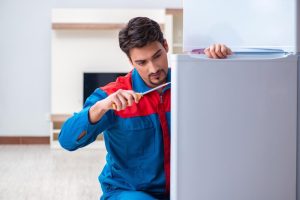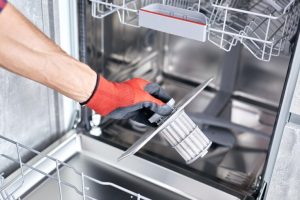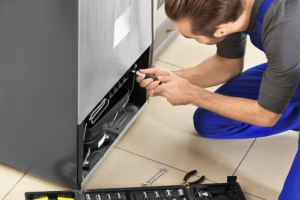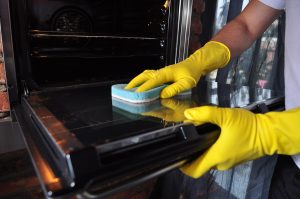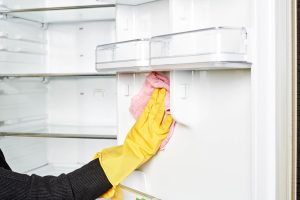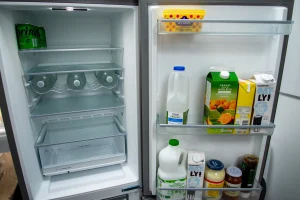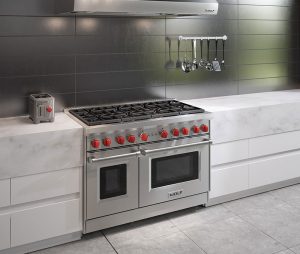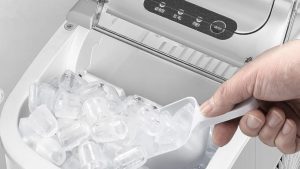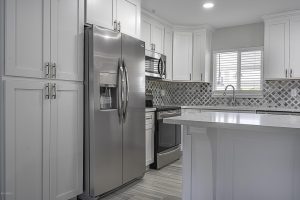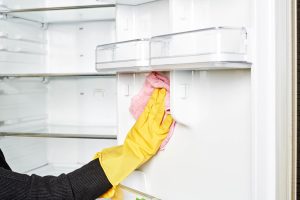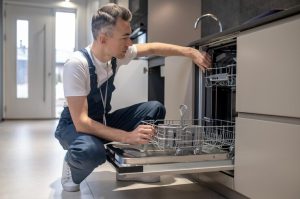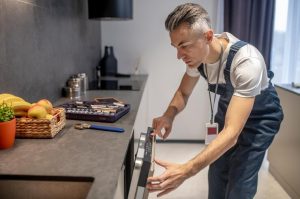Freezers are essential appliances for preserving and storing food for extended periods. However, like any other household appliance, freezers can experience problems that may disrupt their functionality. Being aware of common freezer problems and their solutions can help you address these issues quickly and efficiently. Whether you have a standalone freezer or a freezer attached to your refrigerator, here are some common problems you may encounter.
- Frost Build-Up:One of the most common issues with freezers is the build-up of frost inside the unit. This can reduce the efficiency of the freezer and lead to increased energy consumption. To solve this problem, regularly defrost your freezer and make sure the seal on the door is intact and properly closing. You can also use a hairdryer to gently melt the frost.
- Temperature Fluctuations:If you notice that the temperature inside your freezer is fluctuating, it can be a sign of a malfunctioning thermostat or compressor. Check the thermostat settings and adjust them if necessary. Also, make sure the vents and air circulation are not blocked by food items. If the problem persists, it might be wise to seek professional help.
- Strange Noises:Unusual noises coming from your freezer can indicate a problem. It could be caused by a faulty fan motor, worn-out belts, or loose components. First, check if there are any loose objects inside the freezer that may be causing the noise. If not, it is best to call a technician to diagnose and fix the issue.
- Water Leakage:Leaking water from your freezer can not only damage your flooring but also indicate a problem with the appliance. The most common cause of water leakage is a clogged defrost drain. Clear the drain using a mixture of warm water and mild detergent. If the problem persists, it could be due to a faulty water inlet valve or damaged drain hose, which should be addressed by a professional.
- Failure to Start:If your freezer fails to start, check if it is properly connected to the power source and that the circuit breaker has not tripped. If everything seems fine, the issue may lie with the compressor or the electronic control board. In such cases, it is best to call a technician for a thorough inspection and repair.
By being aware of these common freezer problems and their solutions, you can troubleshoot and resolve any issues that arise. Regular maintenance and proper care can also help prevent many of these problems from occurring in the first place, ensuring that your freezer remains in optimal condition for a long time.
Common Issues with Freezers
Freezers are essential appliances for keeping food fresh and preserved for a long time. However, they can sometimes encounter issues that can affect their functionality. In this article, we will discuss some common issues that can arise with freezers and their possible solutions.
- Not cooling properly:One of the most common problems with freezers is when they fail to cool as effectively as they should. This can be caused by various factors, such as a dirty condenser coil, a faulty thermostat, or a malfunctioning compressor. To resolve this issue, you can start by cleaning the condenser coil and ensuring that it is not blocked by dirt or debris. If the problem persists, it is advisable to call a professional technician to inspect and repair the thermostat or compressor.
- Excessive frost buildup:Another common issue with freezers is the accumulation of frost on the walls or food items. This can occur due to a damaged door gasket, a faulty defrost timer, or an issue with the defrost heater. To address this problem, you can check the door gasket for any signs of wear or damage and replace it if necessary. Additionally, you can manually defrost the freezer and observe if the issue persists. If it does, it might be necessary to replace the defrost timer or heater.
- Unusual noises:Unusual noises coming from the freezer can be alarming and indicate a problem. These noises can occur due to a faulty evaporator fan motor, a damaged compressor, or a clogged drain tube. To fix this issue, you can start by cleaning the drain tube using a mixture of water and vinegar. If the noises continue, it is recommended to consult a professional to determine the cause and perform any necessary repairs or replacements.
- Door seal problems:A damaged or worn-out door seal can lead to air leaks and cause the freezer to work harder to maintain the desired temperature. To resolve this issue, you can inspect the door seal for any signs of damage and replace it if needed. Additionally, you should ensure that the door is always properly closed to prevent air leaks and ice buildup.
- Frequent power outages:Freezers can be affected by frequent power outages, especially in areas with unstable electrical supply. This can spoil the stored food and affect the freezer’s performance. To prevent this issue, it is advisable to invest in a backup power supply, such as a generator or an uninterruptible power supply (UPS), to keep the freezer running during power outages.
In conclusion, while freezers are generally reliable appliances, they can experience common issues that can hinder their performance. By following the suggested solutions for these issues, you can ensure that your freezer remains in optimal condition and continues to preserve your food effectively for a long time.
Freezer Not Cooling
If your freezer is not cooling properly, it can be a frustrating experience. Fortunately, there are several common problems that can cause this issue, and many of them can be fixed easily.
- Power Supply:Check if the freezer is plugged in and getting power. Make sure the outlet is working properly by testing it with another appliance. If the outlet is faulty, try plugging the freezer into a different outlet.
- Temperature Settings:Check the temperature settings on the freezer. Make sure it is set to the desired temperature and not accidentally turned off or set to a warmer temperature. Adjust the temperature settings if necessary.
- Door Seals:Inspect the door seals for any cracks, gaps, or tears. Damaged door seals can allow warm air to enter the freezer, causing it to not cool properly. Clean the door seals and replace them if necessary.
- Dirty Condenser Coils:Over time, the condenser coils can accumulate dust and dirt, causing the freezer to not cool properly. Clean the condenser coils using a vacuum cleaner or a soft brush to remove the debris.
- Frost Build-up:Excessive frost build-up can interfere with the freezer’s cooling ability. Defrost the freezer by unplugging it and letting it thaw for 24 hours. Remove any excess frost or ice using a plastic scraper, being careful not to damage the interior surfaces.
- Insufficient Air Circulation:Make sure there is enough space around the freezer for proper air circulation. Rearrange any items or furniture that may be blocking the airflow. Avoid overloading the freezer with too many items, as it can restrict the airflow and prevent proper cooling.
- Faulty Thermostat:If all else fails, the thermostat may be faulty. Contact a professional technician to inspect and replace the thermostat if necessary.
Remember, if you are unsure about any repairs or if the problem persists, it is always best to consult a professional technician to avoid causing further damage to the freezer.
Frost Build-Up in Freezer
One common problem that many people encounter with their freezers is frost build-up. Frost build-up can occur for several reasons, including a faulty door seal, frequent door openings, or a malfunctioning defrost system. If left unchecked, frost build-up can not only decrease the efficiency of your freezer but also make it difficult to find and access the items stored inside.
To address frost build-up in your freezer, there are a few steps you can take. First, check the door seal to ensure it is properly sealing the freezer. If you notice any gaps or tears in the seal, you may need to replace it. This will help prevent warm air from entering the freezer and causing frost to form.
Next, try to limit the number of times you open the freezer door. Each time the door is opened, warm air enters the freezer, causing the temperature to rise and potentially leading to frost build-up. Consider removing all the items you need from the freezer at once, instead of opening it multiple times throughout the day.
If the above steps do not resolve the issue, it is possible that your freezer’s defrost system is malfunctioning. The defrost system is responsible for melting any frost that accumulates on the evaporator coils. If the system is not working correctly, frost can build up rapidly. In this case, it may be necessary to call a professional technician to diagnose and repair the problem.
Regular maintenance can also help prevent frost build-up in your freezer. Make sure to clean the freezer regularly, removing any spilled food or ice. Additionally, defrosting the freezer periodically can help remove any existing frost and keep the appliance running efficiently.
By addressing frost build-up in your freezer promptly and taking preventive measures, you can ensure that your appliance runs smoothly and efficiently, keeping your frozen goods in optimal condition.
Strange Noises Coming from Freezer
If you are hearing strange noises coming from your freezer, it can be concerning and indicate a potential issue. Here are some common causes for these noises and their possible solutions:
- Humming or buzzing noises: These noises are typically caused by the freezer’s compressor. If the noise is loud or continuous, it could be a sign of a faulty compressor. In this case, it is best to contact a professional technician to inspect and repair the compressor.
- Rattling or vibrating noises: Rattling or vibrating noises can be caused by loose components or items inside the freezer. Make sure that all containers and food items are properly stored and secured. If the noise persists, check if the freezer is level and adjust the feet or leveling screws accordingly.
- Clicking noises: Clicking noises may indicate a problem with the defrost timer or the start relay. If you hear repeated clicking sounds, it is recommended to have a professional technician inspect and possibly replace these components.
- Dripping or splattering noises: These noises can be caused by ice melting or water dripping onto the defrost heater during the defrost cycle. This is a normal occurrence, and you should not be alarmed unless the noise becomes constant or excessive.
- Gurgling or bubbling noises: Gurgling or bubbling noises are often heard when the refrigerant flows through the system. This is a normal sound and does not indicate any issue with the freezer.
If none of these solutions resolve the noise coming from your freezer or if you notice any other unusual symptoms, it is recommended to contact a professional technician for further diagnosis and repair.
Freezer Leaking Water
If you notice water pooling on the floor around your freezer, it can be a sign of a problem. There are several potential causes for a freezer leaking water, but the most common issues are a clogged defrost drain or a faulty water inlet valve.
Clogged Defrost Drain
Over time, the defrost drain in your freezer can become clogged with debris or ice, causing water to back up and leak out onto the floor. To resolve this issue, follow these steps:
- Unplug the freezer and locate the defrost drain, which is usually located at the bottom of the freezer compartment.
- Remove any debris or ice blocking the drain. You can use a pipe cleaner or a turkey baster filled with warm water to flush out the clog.
- Once the drain is clear, pour a mixture of warm water and mild detergent down the drain to clean it. Rinse with plain water.
- Plug the freezer back in and make sure the water is now properly draining into the pan or tray beneath it.
Faulty Water Inlet Valve
If your freezer has an ice maker or water dispenser, a faulty water inlet valve may be the cause of the water leak. The water inlet valve is responsible for supplying water to these components, and if it is defective, it can lead to leaks. To fix this problem:
- Turn off the water supply to the freezer.
- Locate the water inlet valve, usually located behind the freezer or refrigerator.
- Inspect the valve for any signs of damage or wear.
- If the valve is faulty, replace it with a new one. Refer to the manufacturer’s instructions or consult a professional if needed.
- Turn the water supply back on and check for any leaks. If the problem persists, it may be necessary to call a professional technician.
By addressing these common issues, you can stop your freezer from leaking water and prevent further damage to your appliance and surrounding area.
Freezer Door Won’t Seal Properly
One common problem with freezers is when the door does not seal properly. When this happens, warm air from the surrounding environment can enter the freezer, causing it to work harder and reducing its efficiency. In addition, improper sealing can lead to frost buildup inside the freezer and potential food spoilage.
Possible Causes
There are several possible causes for a freezer door that won’t seal properly:
- Worn or damaged door gasket: The gasket, which is the flexible strip that lines the perimeter of the door, can become worn out or damaged over time. This can prevent the door from sealing tightly.
- Misalignment: If the door is not aligned properly with the freezer body, it may not close fully and create a proper seal. This can occur if the hinges or the door itself are bent or damaged.
- Dirty or obstructed gasket: A buildup of dirt, debris, or food particles on the gasket can prevent it from forming a tight seal against the freezer body.
Steps to Solve the Problem
To fix a freezer door that won’t seal properly, you can follow these steps:
- Inspect the door gasket: Check the condition of the gasket for any signs of wear or damage. If necessary, replace the gasket with a new one.
- Realign the door: If the door is misaligned, you can try adjusting the hinges or the door itself to ensure it closes properly.
- Clean the gasket: Use a mild detergent and water solution to clean the gasket, removing any dirt or debris that may be hindering its sealing ability.
If none of these steps solve the problem, it may be necessary to call a professional appliance repair technician to diagnose and fix the issue.
| Problem | Solution |
| Door gasket is worn or damaged | Replace the gasket |
| Misaligned door | Adjust hinges or door |
| Dirty or obstructed gasket | Clean with mild detergent and water solution |
| None of the above steps solve the problem | Contact a professional appliance repair technician |
Freezer Not Defrosting
If your freezer is not defrosting properly, there are several possible causes and solutions. Here are the most common ones:
1. Blocked Defrost Drain
One of the most common causes of a freezer not defrosting is a blocked defrost drain. Over time, this drain can become clogged with food particles or ice. To fix this issue, you will need to clear the blockage.
To clear the defrost drain, follow these steps:
- Unplug the freezer and remove all the items from it.
- Locate the defrost drain, which is usually found at the back of the freezer.
- Use hot water or a hairdryer to melt the ice blocking the drain.
- Clean the drain with a mixture of warm water and mild detergent.
- Flush the drain with hot water to ensure it is clear.
- Plug in the freezer and wait for it to defrost properly.
2. Faulty Defrost Timer
If the defrost drain is clear but the freezer is still not defrosting, the problem might be a faulty defrost timer. The defrost timer controls when the automatic defrost cycle begins and ends. If the timer is not working correctly, the freezer will not defrost.
To check if the defrost timer is faulty, follow these steps:
- Locate the defrost timer, which is usually located near the temperature control panel or in the freezer compartment.
- Using a multimeter, test the continuity of the defrost timer. If there is no continuity, the timer is faulty and needs to be replaced.
- Replace the defrost timer with a new one compatible with your freezer model.
3. Malfunctioning Defrost Heater
If the defrost drain is clear and the defrost timer is working properly, the issue might be a malfunctioning defrost heater. The defrost heater is responsible for melting the ice on the evaporator coils during the defrost cycle. If the heater is not functioning, the freezer will not defrost.
To check if the defrost heater is faulty, follow these steps:
- Unplug the freezer and remove the rear panel inside the freezer compartment.
- Locate the defrost heater, which is usually a metal coil located near the evaporator coils.
- Using a multimeter, test the continuity of the defrost heater. If there is no continuity, the heater is faulty and needs to be replaced.
- Replace the defrost heater with a new one compatible with your freezer model.
If none of these solutions fix the problem, it is recommended to contact a professional appliance repair technician to diagnose and repair the issue with your freezer.
Remember, before attempting any repairs, always unplug the freezer and follow proper safety precautions.
Freezer Over-Freezing
If you find that your freezer is constantly over-freezing, it can be a frustrating and inconvenient problem. Not only can over-freezing lead to freezer burn and spoilage of your food, but it can also affect the overall performance of your freezer.
One common cause of over-freezing is a faulty thermostat. The thermostat is responsible for regulating the temperature inside the freezer, and if it is malfunctioning, it can cause the freezer to constantly run at a colder temperature than necessary. Check the thermostat settings and adjust them if needed. If the problem persists, it may be necessary to replace the thermostat.
In some cases, a freezer may be over-packed with food, which can prevent the cold air from circulating properly. This can lead to pockets of colder air, causing certain areas of the freezer to over-freeze. Take some time to rearrange the items in your freezer, making sure there is enough space for air to circulate around each item. Consider removing any unnecessary items to create more room and improve airflow.
Another possible cause of over-freezing is a malfunctioning defrost timer. The defrost timer regulates the defrost cycle of the freezer, and if it is not working correctly, it can cause the freezer to over-freeze. You can manually initiate the defrost cycle by locating the defrost timer and turning the dial until you hear a click. If the freezer begins to defrost and the temperature returns to normal, then the defrost timer may need to be replaced.
Poor door seal is another potential culprit of over-freezing. If the freezer door seal is damaged or worn out, cold air can leak out, and warm air can make its way in. This can cause the freezer to run constantly in order to maintain the desired temperature, leading to over-freezing. Inspect the door seal for any signs of damage or wear and replace it if necessary.
If you have tried all the above solutions and your freezer is still over-freezing, it may be time to call a professional technician. They will have the expertise to diagnose and fix more complex issues that could be causing the problem.
Regular maintenance and cleaning can also help prevent over-freezing. Make sure to clean the coils behind or underneath the freezer regularly to improve its efficiency. Additionally, removing any excess ice buildup inside the freezer can help prevent over-freezing.
By identifying and addressing the underlying causes of over-freezing, you can ensure that your freezer functions properly and your food stays fresh for longer periods of time.
Freezer Not Running at All
If your freezer is not running at all, it can be a cause for concern. Here are a few common reasons why this might be happening and some possible solutions:
- Power Supply: Check if the freezer is properly plugged into a working electrical outlet. Make sure that the circuit breaker or fuse connected to the freezer is not tripped. Try plugging in another appliance to the outlet to ensure that it is functioning correctly.
- Temperature Control: Ensure that the temperature settings on the freezer are set correctly. If the temperature control is set too low, it may cause the freezer to turn off. Consult the user manual of the freezer to understand the proper temperature settings.
- Defrost Timer: The freezer may not be running if the defrost timer is stuck in the defrost cycle. Locate the defrost timer, usually found near the control panel or the compressor, and manually advance it to see if the freezer starts running again. If it does, consider replacing the defrost timer.
- Condenser Coils: Dust and debris on the condenser coils can prevent the freezer from running efficiently. Clean the coils using a vacuum cleaner or a soft brush to remove any accumulated dirt. This should help the freezer to run properly again.
- Thermostat: A faulty thermostat can cause the freezer to not run at all. Use a multimeter to test the thermostat for continuity. If there is no continuity, replace the thermostat with a new one.
- Compressor: The compressor is an essential component of the freezer’s cooling system. If it is not running, the freezer will not be able to cool properly. Check if the compressor is receiving power. If it is not, there may be an issue with the compressor itself, and it may need to be replaced.
If none of these solutions resolve the issue, it is recommended to contact a professional appliance repair technician to diagnose and fix the problem. Trying to fix complex issues without proper knowledge or experience may result in further damage to the freezer.
FAQ: Common Freezer Problems and Solutions
My freezer is not freezing properly. What could be the problem?
There are several possible reasons for a freezer not freezing properly. One common issue is a dirty or clogged condenser coil, which prevents the freezer from properly cooling. Another possibility is a malfunctioning thermostat or temperature control, which may need to be replaced. Finally, if the freezer is overfilled, it may not be able to circulate air properly, leading to inadequate cooling.
I notice a lot of frost buildup in my freezer. How can I fix this?
Frost buildup in a freezer can be caused by a few different factors. First, check to see if the freezer door is sealing properly. If there are gaps or cracks in the seal, warm moist air can enter the freezer and cause frost to form. If the door seal is fine, the problem may be with the defrost system. Check to see if the defrost heater and defrost thermostat are working properly. If not, they may need to be replaced.
Why is my freezer making strange noises?
Strange noises coming from a freezer can be concerning, but they are often a sign of a common problem. One possible cause is a malfunctioning evaporator fan motor. This motor helps circulate cold air throughout the freezer, and if it is not working properly, it can create unusual noises. Another potential cause is a faulty compressor or condenser fan motor. It is best to have a professional technician inspect the freezer to determine the exact cause and make any necessary repairs.
My freezer is leaking water. What should I do?
A leaking freezer can be a sign of several different issues. One possibility is a clogged or frozen drain tube. If this tube becomes blocked, water can back up and leak out of the freezer. Another potential cause is a malfunctioning water inlet valve, which may need to be replaced. Additionally, if the freezer is not level, water may be pooling and leaking. Check to ensure that the freezer is sitting level on the floor. If the problem persists, it is best to consult a professional technician for further diagnosis and repair.
What should I do if my upright freezer stops working suddenly?
If your upright freezer stops working suddenly, start by checking the freezer temperature to see if it’s cold enough. Then, troubleshoot the issue by inspecting the freezer parts, including the compressor, and checking for any visible signs of malfunction.
How can I troubleshoot freezer issues if my freezer isn’t freezing properly?
If your freezer isn’t freezing properly, begin troubleshooting by checking the freezer’s temperature. If it’s not cold enough, adjust the temperature settings accordingly. Additionally, inspect the freezer door gasket for any damage and ensure it’s sealing properly.
What are some troubleshooting tips for a freezer that’s too warm?
If your freezer is too warm, check the temperature settings and adjust them if necessary. Inspect the freezer door to ensure it’s closing properly and check for any obstructions around the door seal. Additionally, consider cleaning the walls of the freezer to improve airflow.
How can I prevent my freezer from malfunctioning?
To prevent your freezer from malfunctioning, regularly clean and maintain it according to the manufacturer’s recommendations. Check the temperature of the freezer periodically and ensure proper airflow around the appliance. Additionally, inspect the freezer door gasket for any wear or tear and replace it if necessary.
What steps should I take if my chest freezer stops working unexpectedly?
If your chest freezer stops working unexpectedly, first check the freezer temperature to see if it’s too warm. Troubleshoot the issue by inspecting the compressor and other freezer parts for any signs of damage or malfunction. Consider calling for freezer repair if needed.
How can I troubleshoot a freezer that’s making unusual noises?
If your freezer is making unusual noises, such as clicking or humming sounds, it could indicate a problem with the compressor or other freezer components. Check the freezer temperature and inspect the walls of the freezer for any signs of damage. If the issue persists, contact a professional for assistance.
What should I do if my refrigerator and freezer are both not working?
If both your refrigerator and freezer are not working, check the power supply to ensure the appliances are receiving electricity. Verify the temperature settings for both the refrigerator and freezer compartments and troubleshoot any issues with the compressor or other components.
How can I troubleshoot a freezer that stops working during a sale?
If your freezer stops working during a sale, check the power supply and ensure the appliance is plugged in properly. Verify the temperature settings and troubleshoot any issues with the compressor or freezer parts. If necessary, contact the retailer or manufacturer for assistance.
What could be the problem if my freezer door isn’t sealing properly?
If your freezer door isn’t sealing properly, it could be due to a damaged or worn freezer door gasket. Inspect the gasket for any signs of wear or tear and replace it if necessary. Additionally, check for any obstructions around the door that might prevent it from closing tightly.
How can I troubleshoot a freezer that’s too cold and causing frost buildup?
If your freezer is too cold and causing frost buildup, check the temperature settings and adjust them accordingly. Inspect the freezer door gasket for any damage and ensure it’s sealing properly. Consider cleaning the walls of the freezer to improve airflow and prevent frost buildup.
How can I troubleshoot my freezer if it isn’t working?
If your freezer isn’t working, start by checking the power supply and ensuring it’s plugged in properly. Then, inspect the temperature settings and troubleshoot any issues with the compressor or other freezer components.
What steps should I take if my freezer won’t maintain a cold temperature?
If your freezer won’t maintain a cold temperature, check the temperature settings and adjust them if necessary. Inspect the freezer door gasket for any damage and ensure it’s sealing properly. Additionally, consider cleaning the freezer section to improve airflow.
How can I keep my freezer from becoming too warm?
To keep your freezer from becoming too warm, regularly clean the coils and vents to ensure proper airflow. Check the temperature settings and adjust them as needed. Inspect the freezer door gasket for any wear or tear and replace it if necessary.
What should I do if my freezer can’t freeze food properly?
If your freezer can’t freeze food properly, check the temperature settings and adjust them to a colder setting if necessary. Inspect the freezer door for any obstructions and ensure it’s closing tightly. Consider defrosting the freezer to remove any ice buildup that might be affecting performance.
How can I troubleshoot a warm freezer during a Whirlpool appliance sale?
If your Whirlpool freezer is warm during a sale, check the temperature settings and adjust them accordingly. Inspect the freezer door gasket for any damage and ensure it’s sealing properly. Consider cleaning the coils and vents to improve airflow.
What steps should I take if my freezer is malfunctioning before the sale ends?
If your freezer is malfunctioning before the sale ends, check the temperature settings and adjust them as needed. Inspect the freezer door for any obstructions and ensure it’s closing properly. Consider contacting Whirlpool for assistance if the issue persists.

